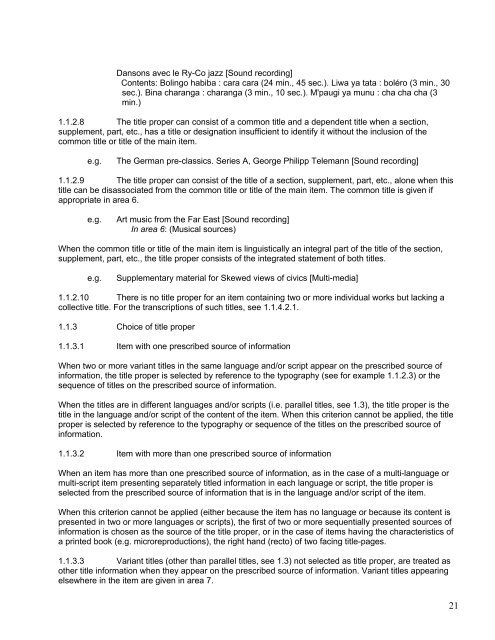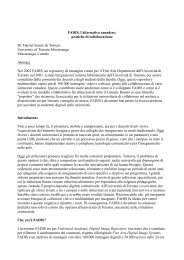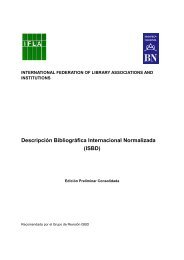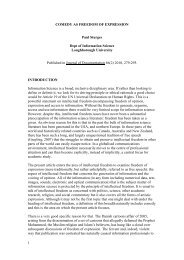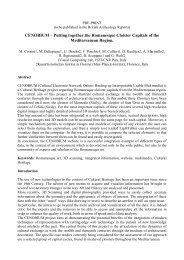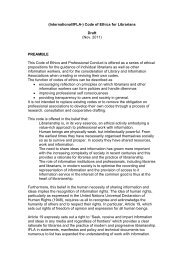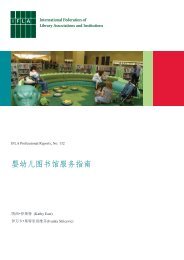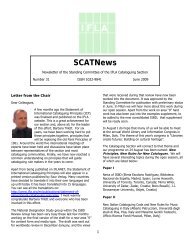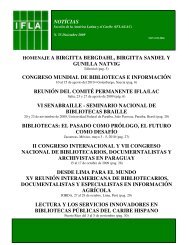ISBD(NBM) - IFLA
ISBD(NBM) - IFLA
ISBD(NBM) - IFLA
You also want an ePaper? Increase the reach of your titles
YUMPU automatically turns print PDFs into web optimized ePapers that Google loves.
Dansons avec le Ry-Co jazz [Sound recording]<br />
Contents: Bolingo habiba : cara cara (24 min., 45 sec.). Liwa ya tata : boléro (3 min., 30<br />
sec.). Bina charanga : charanga (3 min., 10 sec.). M'paugi ya munu : cha cha cha (3<br />
min.)<br />
1.1.2.8 The title proper can consist of a common title and a dependent title when a section,<br />
supplement, part, etc., has a title or designation insufficient to identify it without the inclusion of the<br />
common title or title of the main item.<br />
e.g.<br />
The German pre-classics. Series A, George Philipp Telemann [Sound recording]<br />
1.1.2.9 The title proper can consist of the title of a section, supplement, part, etc., alone when this<br />
title can be disassociated from the common title or title of the main item. The common title is given if<br />
appropriate in area 6.<br />
e.g.<br />
Art music from the Far East [Sound recording]<br />
In area 6: (Musical sources)<br />
When the common title or title of the main item is linguistically an integral part of the title of the section,<br />
supplement, part, etc., the title proper consists of the integrated statement of both titles.<br />
e.g.<br />
Supplementary material for Skewed views of civics [Multi-media]<br />
1.1.2.10 There is no title proper for an item containing two or more individual works but lacking a<br />
collective title. For the transcriptions of such titles, see 1.1.4.2.1.<br />
1.1.3 Choice of title proper<br />
1.1.3.1 Item with one prescribed source of information<br />
When two or more variant titles in the same language and/or script appear on the prescribed source of<br />
information, the title proper is selected by reference to the typography (see for example 1.1.2.3) or the<br />
sequence of titles on the prescribed source of information.<br />
When the titles are in different languages and/or scripts (i.e. parallel titles, see 1.3), the title proper is the<br />
title in the language and/or script of the content of the item. When this criterion cannot be applied, the title<br />
proper is selected by reference to the typography or sequence of the titles on the prescribed source of<br />
information.<br />
1.1.3.2 Item with more than one prescribed source of information<br />
When an item has more than one prescribed source of information, as in the case of a multi-language or<br />
multi-script item presenting separately titled information in each language or script, the title proper is<br />
selected from the prescribed source of information that is in the language and/or script of the item.<br />
When this criterion cannot be applied (either because the item has no language or because its content is<br />
presented in two or more languages or scripts), the first of two or more sequentially presented sources of<br />
information is chosen as the source of the title proper, or in the case of items having the characteristics of<br />
a printed book (e.g. microreproductions), the right hand (recto) of two facing title-pages.<br />
1.1.3.3 Variant titles (other than parallel titles, see 1.3) not selected as title proper, are treated as<br />
other title information when they appear on the prescribed source of information. Variant titles appearing<br />
elsewhere in the item are given in area 7.<br />
21


